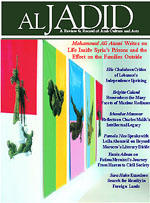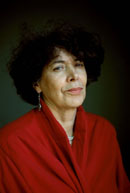Women's Prison: Literally and Figuratively
So Vast The Prison
By Assia Djebar
Translated by Betsy Wing
Seven Stories Press, 1999
By Michelle Reale
 The recent translation of Assia Djebar’s “So Vast the Prison,” which focuses on rights of women in general and those of Algerian women in particular, seems timely in light of the world’s recent concern over the status of women in Afghanistan. In the tradition of Fatima Mernissi and Nawal al-Saadawi, Djebar does not tell her tale linearly and may, at least at the outset, somewhat confuse or bewilder her reader. She attempts to explicate the uneasy existence of Algerian women as they struggle for recognition, rights and the opportunity to transcend the strictures of a tradition that had originally served to “protect” women, but now simply constrains them.
The recent translation of Assia Djebar’s “So Vast the Prison,” which focuses on rights of women in general and those of Algerian women in particular, seems timely in light of the world’s recent concern over the status of women in Afghanistan. In the tradition of Fatima Mernissi and Nawal al-Saadawi, Djebar does not tell her tale linearly and may, at least at the outset, somewhat confuse or bewilder her reader. She attempts to explicate the uneasy existence of Algerian women as they struggle for recognition, rights and the opportunity to transcend the strictures of a tradition that had originally served to “protect” women, but now simply constrains them.
 Though walls may at first feel safe and protective, they eventually close in, creating a prison of sorts. Djebar explores this prison both literally and figuratively. Though the “vastness” of a “prison” seems paradoxical, the reader comes to see how this seeming contradiction exists for the women of this narrative, particularly Isma. Isma is a professional, educated, well-heeled woman who seems to function in her environment but who, apparently, has reached society’s limitations. In the numerous limitations that outmatch Isma’s far-reaching aspirations, the reader sees the vastness of her prison.
Though walls may at first feel safe and protective, they eventually close in, creating a prison of sorts. Djebar explores this prison both literally and figuratively. Though the “vastness” of a “prison” seems paradoxical, the reader comes to see how this seeming contradiction exists for the women of this narrative, particularly Isma. Isma is a professional, educated, well-heeled woman who seems to function in her environment but who, apparently, has reached society’s limitations. In the numerous limitations that outmatch Isma’s far-reaching aspirations, the reader sees the vastness of her prison.
The first section features Isma and her story as she falls in love with a younger man, her “Beloved,” who happens to work in the same building where she works as a musicologist. The reader who is unfamiliar with the history of Algeria, the loss of women’s rights there and women’s painful existence under the yoke of French colonialism may bristle at the idea that this story centers on a spoiled and capricious woman, because to them it will seem that Isma is anything but. Djebar uses Isma’s unfulfilling marriage and subsequent infatuation with the younger man as an introduction to the idea of “prison.” Isma is, by all appearances, a modern woman unfettered by the religious and societal constraints imposed on traditional Algerian women. She attempts to reconcile her life through maintaining a marriage more institutional than loving and through raising two children, though all the while she is falling deeply and desperately in love with this younger man. Emboldened by her husband’s inkling of something amiss and his apparent willingness to hear her side of the story, Isma naively reveals her heart’s desire. Her husband immediately retaliates with violence aimed at the very window of her soul: her eyes. Narrowly escaping blindness and realizing astutely that she no longer has control over her life, Isma eventually leaves her husband.
In this book, men become the enemy. Indeed, when the “women are speaking among the women,” the husband is referred to as the “enemy.” Though Djebar discusses the “enemy” as a shared problem, she gives less attention to the collective struggle among Algerian women than to Isma’s individual plight in the narrative. Isma struggles (there is no doubt), but she is an insular character, and the reader is likely to lose patience with her preoccupation with her own troubles. After all, what did Isma expect would happen to her upon revealing her feelings for her “Beloved” to her husband? Irritation begins to set in for the reader, but Djebar drones on. The violence against women is horrifying, and the reader understands the near blinding of Isma as both a literal and figurative denial of the validity of a woman’s experience through what she sees. However, Isma seems to be more of a petulant and selfish person than a “victim.” Despite missing the mark slightly, this is the most readable section of the book and offers the clearest picture of how Isma’s individual life fits within the broad context of Algerian women.
The reader is momentarily disoriented when the second of four sections of the book takes a decided turn — a turn back in time, that is. Djebar explores language through the story of the discovery of a stele, on which is inscribed a bilingual inscription that many have attempted to decipher over the centuries, in Dougga. This long and drawn out account becomes wearying and seems, at least initially, to be so irrelevant to the first section of the book that the reader might be tempted, for a second time, to abandon the book altogether.
In the book’s third section, the reader encounters Isma once again, though this time she is undertaking a filmmaking project. Djebar attempts to make the point that language is highly manipulative and that it changes over time by having Isma use the languages of North Africa and, more specifically, the Berber or Amazigh language in her film. Despite this mutability of language, Isma finds the story she wishes to tell somehow frozen. Though she realizes that different interpretations will be conferred upon her work, thereby adding new ideas to the original work, she also understands that a film can preserve a vision. Isma’s film, entitled “Arable Woman,” tells the journey of a woman’s life. Through this narrative of Isma’s filmmaking, Djebar relates Isma’s relationships with both her mother and her grandmother in sequences that seem more like dreams than reminiscences and memories discolored by hindsight.
In the novel’s fourth section, which is both wistful and lyrical, we meet Yasmina, a Franco-Algerian woman, and observe her return to Algeria with a female Polish friend. In a strange and fateful twist, Yasmina and her friend are approached by terrorists masquerading as police. They seize her friend for questioning, but Yasmina relentlessly pursues the perpetrators and ultimately offers herself in exchange for her friend. Yasmina is found in a ditch the next day, mutilated. Her friend had managed to safely leave the country the day before. Algeria, it seems, requires the shedding of blood on one level or another. Though this short section depicts just one tragic account, the reader knows through Djebar’s narration that there are many others with similar experiences whose stories will never be told.
Writing over a period of years, Djebar uses a variety of genres and techniques such as poetry, fiction and raw emotional language to convey the history of a language, an entire people and one woman within that population. Djebar does not avert her gaze from any of the violence or happenings in her country, giving her thoughts and the language she uses to convey them extraordinary depth, though at times she delivers a portion too large to consume. Still, one knows that Djebar has not exhausted her topic. Those interested in women, language and the history of Algeria will gain much insight from such an inventive approach to these subjects.
In the final estimation, language is a potent weapon, and silence is not an option. Perhaps like Djebar, Isma contemplates the hope inherent in being able to make one’s way and to forge ahead despite the obstacle of being a woman. Djebar writes, “Even today all that I seek, far from ‘salvation,’ and for want of ‘grace,’ is the feel of passages — sometimes they are too slight, but even then, even if they may be too narrow, at least they let my searching gaze arrive ahead of me.”
This review appeared in Al Jadid (Vol. 7, no. 37, Fall 2001).
Copyright (c) 2001 by Al Jadid
Link : www.aljadid.com
Assia Djebar picture from: GIOVANNETTI
scarica versione per stampa